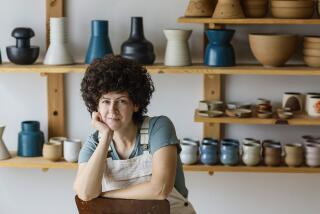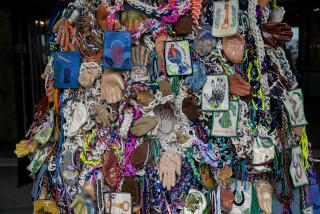Young Men Learning to Forge Ahead : Blacksmith Teaches Craft to Anvil Chorus of Praise
- Share via
As high school classrooms go, it isn’t much. The walls are wire mesh; the floor is concrete. Space is tight.
And the last thing you’ll see are books.
But for Martin Kruse, self-employed knife-maker and part-time teacher of basic blacksmithing at Highland Hall, a private school in Northridge, this semi-outdoor classroom is just fine.
With his stocky build, long hair and beard, Kruse looks and sometimes sounds like a person who just stepped from behind an old frontier-town forge.
“Don’t make me act like a teacher, OK?” Kruse demanded, at the start of this year’s new class. “I get real cranky when I have to do that.”
“Yeah. Mr. Kruse gets real cranky,” said a student. But he was smiling. The others grinned too.
Kruse wears a heavy leather apron over jeans and a plaid shirt when blacksmithing. A beaten and stained, beaver-felt four-point Stetson hat rests comfortably on his head.
One of a rare breed--he knows of fewer than half a dozen full-time forge-using blacksmiths in the Los Angeles area--Kruse has taught the class since last year. He hopes it might help to rekindle interest in a profession that he loves, but that to many seems irrelevant today.
Mastering Skills
In his class, students learn to use a forge to make nails, wrought-iron barbecue forks, coat hooks and a simple knife blade--and to repair the school’s gardening tools.
“It helps get rid of that mentality--’It’s bent, let’s go and buy another one,’ ” Kruse said.
He himself rarely, if ever, works on such simple projects. Instead, he applies himself to what he calls “the highest craft in blacksmithing,” working with high-carbon steel.
He shapes the steel by heat and hammer to produce his handmade knives. Then he ensures that the knife will hold a durable, razor-sharp edge by heating it 1,600 degrees Fahrenheit and cooling it quickly in olive oil, a process called “quenching.” It is difficult, hazardous work, in which the slightest miscalculation can cause disaster. By comparison, wrought iron--mild-metal steel--is easy. In fact, Kruse said, mild-steel work bores him.
“The teaching keeps me sharp,” he said. “The students make mistakes which never occur to me. They stretch my capabilities.”
And some of the students he has taught at Highland Hall, Kruse said, “are potentially really good.”
Making sure that his 15-year-old male students--who work with fires and red-hot metals--are disciplined and safe is no easy task. Kruse does it by assuming a stance of uncompromising toughness. His communication, blunt and to the point, leaves no room for misunderstandings.
‘Word Is Work’
“This is a workshop. The operative word is work. Get that?”
Clearly, however, he genuinely cares about the boys’ well-being. The students wear safety goggles at all times and clothes made of cotton. Polyester, which burns easily or melts and can cause serious burns, is strictly prohibited.
The class safety record is a point of pride with Kruse, and reflects, he believes, adherence to his strict rules in class. Last year, only one student was burned, a small second-degree burn, when he tried to pick up a bar that had lost enough heat to return to its normal color but was still hot.
The two forges look like large upside-down lids. Each forge carries a small mound of coal, and from its underbelly hangs a corrugated-rubber hose attached to a cast-iron, hand-cranked air-blower. The blower drives air through the forge and increases the temperature of the fire.
Once the fires are lit and burning, the class quickly becomes patterned into a weaving, ceaseless movement of human bodies: from blower to fire to anvil; from anvil to fire to blower. Beating, turning, picking up, putting down, cranking the blowers, and once again beating the iron.
Kruse, completely absorbed, becomes both choreographer and participant in this dance. Talking almost non-stop when needed, he directs his attention first to one student, then another.
“Slow down, you don’t need to burn it up, just keep it steady.”
Then, “Whoa, we don’t need Mount Vesuvius in there.”
“Bobby,” he said in an exasperated tone, turning to a student sprinkling water on his forge with a long-handled ladle, “you’re not making mud pies. You’re looking to steam off the impurities.”
Then, back at an anvil: “Hit that sucker, OK?”
Greg Anastas, 15, hammered at the red-hot metal that was soon to become his first hand-crafted nail.
Blacksmithing is hot, hard and hazardous work, and by the time the class was over the students had worked up a sweat. Coal dust was smeared across arms and faces.
Intense Concentration
After nearly two hours of labor they looked tired. The work requires constant effort, tremendous concentration.
Curiosity drove Greg Anastas to try blacksmithing. He’s pleased he did. “It’s the funnest class,” said Greg, who now rates blacksmithing with cross-country running, wood-carving and chemistry as his favorite classes.
Bob Ramirez and Craig Ernst entered the class this year with more experience. Both 15-year-old sophomores have chosen a second year in Kruse’s class. Academically oriented and planning possible careers in law or medicine, they discovered they enjoyed the physically demanding work, finding it made a welcome break from their academic studies.
“I like it. It’s fun. It’s enjoyable,” Ernst explained. “Yes, it’s hard work. You get dirty; you sweat, and you have to concentrate all the time. If just one person isn’t paying attention, someone could get hurt.”
More to Read
Sign up for Essential California
The most important California stories and recommendations in your inbox every morning.
You may occasionally receive promotional content from the Los Angeles Times.










